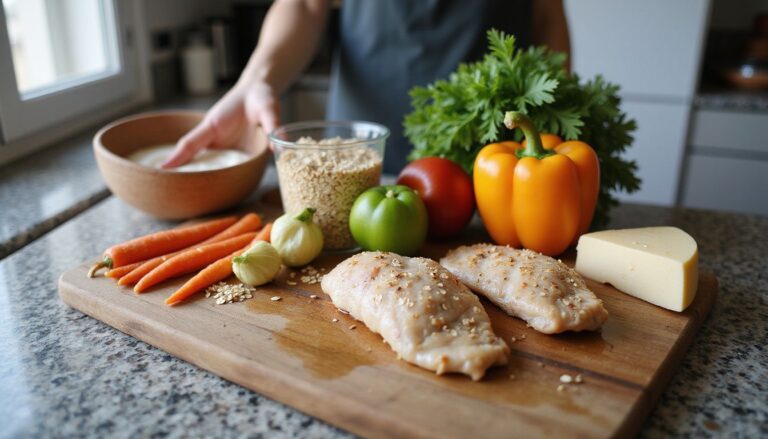Best Way To Lose Weight For Women: Effective Tips For Rapid Weight Loss
Our Nutrition Assistant AI Suite will transform your body. You will lose fat, get toned, and build muscle. Gain confidence and optimal health.
Trying to lose weight can feel tiring when the scale does not move. Many women also face hormone shifts and a slower metabolism, which makes progress harder. Evidence-based steps can help you lose weight safely and keep it off.
This guide shares simple, proven ways to build a calorie deficit, move your body, and improve daily habits. The focus is on healthy eating, regular physical activity, and practical tools for rapid weight loss done the safe way.
Read on to find a plan that fits your life and delivers steady results.
Key Takeaways
- Aim for a calorie deficit of 500 to 750 calories per day, pair aerobic and strength training, and choose fiber-rich whole foods. These steps match CDC and Mayo Clinic advice.
- Safe progress is 1 to 2 pounds per week. Very low-calorie diets below 800 calories require medical supervision due to higher risks.
- Hormonal changes, including menopause or thyroid issues, can slow metabolism and raise abdominal fat. This can make weight loss tougher for women.
- Intermittent fasting and time-restricted eating may lead to about 3 percent weight loss in three months. Talk with a clinician before you start.
- Prescription options such as Orlistat or Semaglutide, plus structured programs, can support a 5 to 10 percent drop in body weight when lifestyle changes alone stall.

Understanding Weight Loss for Women

Women do not respond to diets exactly like men do. Hormones and muscle mass affect energy use, hunger, and where fat is stored. Knowing these differences helps you pick diet strategies that work for you.
How do hormones affect weight loss in women?
Estrogen and progesterone shift across the month. These hormones influence hunger, energy use, and fat storage. Lower estrogen after menopause can slow metabolism and raise belly fat.
Cravings before your period are common. Stress raises cortisol, a hormone that pushes you toward high-calorie snacks, which can block rapid weight loss. Thyroid hormones set your resting calorie burn. If they are off, you may gain weight even with a healthy diet plan.
Even small hormone changes can make losing 1 to 2 pounds per week feel hard. One Mayo Clinic patient said, “I used to eat less but could not lose those last 10 pounds until I managed my stress better.”
If you think hormones are a barrier, ask your healthcare professional for testing and a tailored eating plan. Support early prevents setbacks later.
Why is women’s metabolism different from men’s?
Women usually have more adipose tissue, which is body fat, and less muscle than men. Muscle burns more calories at rest than fat. This means many women use fewer calories each day for the same activity.
Men often have a basal metabolic rate that is 5 to 10 percent higher than women of similar age and size. Hormone changes across life stages also shift energy use. During pregnancy or menopause, metabolism can slow and hunger can rise.
Your calorie needs may be lower, yet your nutrient needs stay high for bone health, heart health, and hormone balance. Clients who focus on whole grains, lean protein, fruits, vegetables, and healthy fats see better long-term results than those who only cut calories.
These differences point to a smart strategy. Protect muscle with strength training, set realistic goals, and aim for steady fat loss, not crash dieting.
How can women set realistic weight loss goals?
Realistic goals lower pressure and boost consistency. Start with small, steady changes that help you maintain a healthy weight and build habits that last.
What does losing 1-2 pounds per week look like?
To lose about 1 to 2 pounds per week, create a daily deficit of 500 to 750 calories. You can lower intake, increase activity, or do both. For instance, if you eat 2,000 calories now, aim for 1,250 to 1,500, or burn more through exercise.
Set a modest goal, like losing 5 percent of your current weight. For a 180 pound person, that is 9 pounds. This aligns with CDC and Mayo Clinic guidance and helps prevent weight cycling.
Steady loss lowers the risk of type 2 diabetes and heart disease. Progress may feel slower, but it leads to better health and more control.
Why focus on long-term weight loss changes?
Quick diets can take weight off fast, then it creeps back. Long-term change sticks. Eat more vegetables, choose whole grains, and move at least 30 minutes most days.
Research from the U.S. Department of Health and Human Services shows that sustainable habits keep pounds off and improve blood pressure. Planning for holidays or busy seasons helps you stay on track.
Slow change guards your muscle, improves body composition, and lowers disease risk. Small steps add up to long-term weight loss and better health.
Effective Dietary Modifications
Food choices drive most weight loss. Simple swaps and portion control make a big difference for weight loss and maintenance.
How do you create a calorie deficit for weight loss?
Cut 500 to 750 calories per day to lose about 1 to 2 pounds per week. This aligns with the Dietary Guidelines for Americans. Use smaller plates, fill half your plate with vegetables, and eat lean protein at each meal.
Replace sugary drinks with water or unsweetened tea. Track what you eat and drink in an app or notebook. That record makes hidden calories easy to spot.
Meals high in dietary fiber and protein keep you full longer. Feeling satisfied helps you stick to your plan without constant hunger.
What fruits, vegetables, and whole grains help with weight loss?
High fiber foods fill you up with fewer calories. They also support a steady blood sugar level and easier portion control.
- Eat at least four servings of vegetables daily, like spinach, broccoli, carrots, or bell peppers.
- Choose three servings of fruit per day. Apples, berries, and oranges satisfy sweet cravings with fewer calories.
- Pick whole grains such as brown rice, quinoa, and whole-wheat bread instead of refined grains.
- Aim for five portions of fruits and vegetables daily, around 80 grams each, a common heart-health target.
- Leafy greens and berries support circulation and may reduce abdominal obesity.
- Oats and barley can help lower the risk of cardiovascular disease and type 2 diabetes.
- Limit refined foods made with white flour or lots of added sugar.
- Base meals around plants. Diets high in produce and whole grains lower the risk of hypertension, heart disease, and some cancers.
- Enjoy nuts like almonds or walnuts in small portions. They help with fullness but are calorie dense.
- Add whole-grain snacks to reduce hunger between meals.
Why should processed foods and added sugar be reduced?
Processed foods often pack added sugar, sodium, and unhealthy fats. These raise calories fast and make it harder to reach a healthy weight. Desserts, soda, and sweet coffee drinks are common culprits.
Choose fruit for sweetness and fiber. Select low-fat or fat-free dairy to save calories while keeping nutrients. A large review found that cutting processed foods lowers the risk of heart disease and type 2 diabetes.
Lean proteins, vegetables, whole grains, and nuts support steady progress. Next, compare low-carb and low-fat styles to see which fits your taste and routine.
What are the benefits of low-carb versus low-fat diets?
Both low-carb and low-fat plans can help with weight loss if they create a calorie deficit. Pick the style that you can follow consistently.
| Aspect | Low-Carb Diet | Low-Fat Diet |
|---|---|---|
| Definition | Limits carbohydrates from grains, sugars, and starchy vegetables. | Restricts total fat, especially saturated and trans fats. |
| Calorie Deficit | Promotes using fat for energy, which can aid a deficit. | Cuts calories because fat has 9 calories per gram. |
| Evidence for Weight Loss | The 2018 Stanford DIETFITS trial found similar long-term loss to low-fat when calories are controlled. | Strong research shows modest, steady loss, especially with exercise and portions. |
| Blood Sugar Effects | May steady blood sugar and reduce insulin spikes, helpful for PCOS or prediabetes. | Can improve cholesterol if focused on whole foods and healthy fats. |
| Appetite Control | Higher protein and fat often increase fullness and reduce cravings. | Fiber from whole grains and beans helps, though hunger may return sooner. |
| Sample Foods | Lean meats, eggs, non-starchy vegetables, nuts, cheese. | Whole grains, fruits, vegetables, lean proteins, low-fat dairy. |
| Best For | Women who feel bloated after carbs or struggle with sugar cravings. | Women who want heart-smart options and a varied plant-based plate. |
| Professional Recommendation | Consider for insulin resistance or metabolic syndrome after medical advice. | Suitable for many adults when portions and unsaturated fats are prioritized. |
| Potential Drawbacks | Low energy during intense workouts if carbs are too restricted. | May lack essential fats if fat intake is too low. |
| What to Expect Early On | Reducing carbs for two weeks may lessen bloating and show quick scale changes. | Choosing low-fat yogurt and whole grains in the morning often supports steady energy. |
What role does exercise play in losing weight?
Exercise helps create your calorie deficit and protects muscle as you lose fat. Think of it as the engine that keeps your metabolism active.
How can cardio exercises help with weight loss?
Cardio like brisk walking, cycling, or swimming burns calories each session. Aim for at least 30 minutes most days. A 160 pound person walking moderately for 30 minutes may burn about 150 calories.
Daily walking helped me drop fat faster once I paired it with a low-calorie diet. People who keep up with cardio tend to lose more weight than those who rely on food changes alone.
Cardio also supports heart and lung health. Combine it with strength training to keep muscle while losing body fat.
Why add strength training to boost metabolism?
Strength work two or more days per week builds muscle. More muscle raises resting calorie burn, which supports weight maintenance.
In my own plan, lifting weights made me stronger, and the scale moved more predictably. If your goal is efficient fat loss without losing muscle, add strength sessions to your weekly routine.
How to choose enjoyable activities for sustainable exercise?
Consistency matters more than perfection. Pick activities you actually enjoy.
- List past favorites like walking, swimming, dancing, or biking.
- Choose low-impact options if joints or veins bother you.
- Invite friends or family to boost accountability and fun.
- Schedule workouts like any important appointment.
- Head outdoors if you like fresh air and sunlight.
- Try group classes such as dance or yoga to reduce stress.
- Pick settings where you feel comfortable, home or gym.
- Test new activities now and then to avoid boredom.
- Note your mood after workouts. Positive feelings help the habit stick.
Lifestyle Changes to Support Weight Loss
Daily habits shape results. Small upgrades to sleep, stress, and routines can speed results and protect your health.
How does quality sleep impact weight loss?
Get 7 to 9 hours of quality sleep. Poor sleep disrupts hunger and fullness hormones, which can raise cravings for sugar and salty snacks.
Low sleep can also drain your energy for workouts. Better rest supports mindful eating, a stable mood, and stronger willpower. Solid sleep makes every other habit easier.
What are effective stress management techniques like yoga or meditation?
Stress pushes many people to eat more. Managing stress supports weight loss and long-term maintenance.
- Practice yoga to improve breathing and lower cortisol, a stress hormone linked to weight gain.
- Meditate 10 minutes daily. It reduces emotional eating and helps control cravings.
- Use slow, deep breathing to calm your body during tense moments. This steadies your heart rate and helps you reset.
- Use mindfulness before meals. It improves portion control and food choice.
- Set quick “pause” reminders on your phone for brief relaxation breaks.
- Seek professional care if chronic stress blocks progress. Therapy or coaching can help.
- Join local yoga or meditation groups. Community support increases consistency.
How to stay consistent with healthy habits?
Yoga and meditation help, yet daily structure keeps you moving forward. Keep your system simple and repeatable.
- Track meals and activity in a journal or app for accountability.
- Set phone reminders for workouts and meals.
- Plan meals ahead and carry nutrient-dense snacks.
- Find a partner or group for support.
- Celebrate progress, like a pound lost or a week of logging.
- Prepare for busy days with quick meal options and short home workouts.
- Drink at least 64 ounces of water daily.
- Sleep at least 7 hours most nights.
- Use stress tools like writing or breathing exercises.
- Schedule check-ins with a dietitian or healthcare provider.
Logging my meals and workouts on my phone kept me honest and motivated. It also kept me away from fad diet traps and focused on nutrient-dense foods.
Exploring Rapid Weight Loss Strategies
Some methods can speed results, but safety comes first. Use medical guidance for any aggressive plan.
What is intermittent fasting and how does it work?
Intermittent fasting alternates between eating and fasting windows. A common pattern is 16 hours fasting and 8 hours eating, like noon to 8 p.m.
Some choose alternate-day fasting or lower calories a few days each week. These patterns may improve insulin sensitivity and lower overall calorie intake. They can reduce fat while keeping muscle if protein and strength training remain in place.
Always check with a healthcare professional before starting, especially if you are pregnant, breastfeeding, or have a medical condition. A clinician can help you avoid nutrient gaps and guide you on safe timing.
How does time-restricted eating aid weight loss?
Time-restricted eating limits daily eating to set hours, such as 8 to 10 hours. Fewer hours to eat often means fewer total calories.
Many people also choose more nutrient-dense foods. A 2020 study showed adults who ate within an 8-hour window lost about 3 percent of their body weight in three months.
I tried a 10 a.m. to 6 p.m. window for two weeks. Avoiding late-night snacks cut cravings. Keep lifting and moving to protect muscle while using this strategy.
What are very low-calorie diets (VLCD) and are they safe?
Very low-calorie diets provide under 800 calories per day. They are used short term under close medical supervision, especially in severe obesity.
VLCDs can bring quick fat loss. They can also cause muscle loss, gallstones, fatigue, and nutrient deficiencies if not managed well. Doctors often use meal replacements with vitamins and minerals to control intake.
These plans are not for routine dieting without medical care. Discuss risks and benefits with your clinician before you consider this path.
Medical and Professional Support
Expert help can speed progress and reduce risks. Guidance is vital if you have health conditions or need extra support.
When should you consult a healthcare professional for weight loss?
Talk with a clinician if stress, medical issues, or emotions make weight loss difficult. Get checked for conditions that affect metabolism, like thyroid disease or diabetes.
Professional support is key if you are considering prescription medications or very low-calorie diets. If lifestyle changes stall despite your best effort, a clinician can adjust your plan safely.
What prescription weight loss medications are available?
Medicines may help when diet and exercise alone are not enough. A physician will decide what fits your health history and goals.
- Orlistat blocks some fat absorption. It works best with a structured meal plan.
- Phentermine reduces appetite short term under medical supervision.
- Liraglutide acts on appetite signals and may support 5 to 10 percent weight loss in a year.
- Naltrexone-bupropion affects brain pathways that control cravings and fullness.
- Semaglutide is an injection that targets appetite and often leads to larger weight loss.
- These medications work best with regular exercise and high-quality meals.
Medications are not a quick fix. They are tools that work alongside healthy habits. Possible side effects vary, so follow your doctor’s advice.
How do supervised weight management programs work?
Structured programs add coaching, support, and clear steps. For example, UC Davis Health offers “Achieving a Healthy Weight” and “Living Light Living Well.”
You get personalized advice, meal planning help, group meetings, and check-ins. Coaches help adjust calories, troubleshoot plateaus, and build exercise routines. Research shows that people in structured programs lose more weight and maintain it longer than those who go it alone.
If you want more support without medication, a program can raise your odds of success.
Tips for Staying Motivated
Motivation comes and goes. Simple systems keep you moving forward on tough days.
How can tracking your progress help weight loss?
Use a food diary, journal, or app to track meals and workouts. Seeing your patterns makes it easier to adjust portions and spot added sugar.
People who log consistently tend to lose more weight over time. In one 2019 study, app users had greater success over six months. Tracking helped me stay mindful at restaurants and family events.
| Tool | Benefit |
|---|---|
| Food diary or journal | Reveals eating patterns and triggers |
| Mobile tracking apps | Improves accountability and feedback |
| Exercise logs | Measures activity level and progress |
Make tracking a daily habit to support steady, healthy weight loss.
Why celebrate small milestones?
Small wins, like losing a pound in a week or finishing every workout, build momentum. Celebrating keeps you engaged and less likely to quit when the week gets busy.
Mark your wins on a calendar or take a quiet walk as a reward. Positive feedback strengthens commitment.
How to find a workout or accountability partner?
Share your goals with a friend or family member. Join a class, a local club, or an online community focused on weight loss for women.
I once asked my sister to track steps with me. We kept each other honest, and both of us stayed consistent longer.
Celebrate milestones together. Partner support makes the journey more enjoyable.
Common Mistakes to Avoid
A few missteps can stall progress. Avoid these common traps to keep results steady.
Why is skipping meals harmful for weight loss?
Skipping meals often backfires. Hunger later can lead to overeating or grabbing high-sugar snacks. Blood sugar swings may leave you tired and less focused.
Eating regular meals supports energy and better choices. Balanced plates make it easier to stick to your plan.
What are the risks of relying on fad diets?
Fad diets promise fast results but are hard to maintain. They often cut whole food groups and can lead to nutrient gaps and low energy.
Many people regain the lost weight, sometimes even more. Choose a balanced plan that fits your life and supports long-term health.
How can overtraining and under-eating affect results?
Too much exercise with too few calories can slow your progress. Low fuel reduces recovery, raises injury risk, and can disrupt hormones.
Some people feel exhausted, crave more sugar, and stop seeing results. Balanced eating plus strength training supports steady success without burnout.
Additional Weight Loss Tips
Small daily actions stack up fast. These simple tips help you keep momentum.
How important is staying hydrated?
Hydration supports metabolism and appetite control. Swapping sugary drinks for water cuts calories right away.
Women need about 11.5 cups of fluids per day. I found that drinking water before meals reduced cravings and helped me eat less without feeling deprived.
What are nutrient-dense meals and why focus on them?
Nutrient-dense meals deliver vitamins, minerals, and fiber for fewer calories. Think vegetables, fruits, whole grains, beans, lean proteins, and healthy fats.
A salad with grilled chicken and brown rice gives protein and fiber. A fast-food meal can have similar calories but far fewer nutrients. People who favor nutrient-dense meals often lose weight more consistently and keep it off.
Why limit alcohol consumption during weight loss?
Alcohol has seven calories per gram and adds little nutrition. A glass of wine has about 120 calories. Mixed drinks often have more due to added sugar.
Cutting back keeps your calorie deficit intact and helps you make better food choices later in the night. I reduced drinks from three per week to one and saw my weekly progress speed up.
Benefits of Achieving a Healthy Weight
Healthy weight brings daily wins. You feel stronger, more confident, and more active in your life.
How does losing weight reduce chronic disease risks?
Losing 5 to 10 percent of your weight can improve blood pressure, cholesterol, and blood sugar. These changes lower the risk of heart disease and type 2 diabetes.
Lower body fat reduces inflammation and helps protect your joints and heart. Keeping a healthy weight also supports long-term brain and liver health.
In what ways does weight loss improve energy and mood?
Weight loss often boosts physical activity and sleep quality, which improves mood. Exercise raises endorphins, your feel-good chemicals.
Balanced meals steady blood sugar so you avoid late-day crashes. Many women report feeling more alert and positive as they progress.
How does a healthy weight enhance quality of life?
Life feels easier when your body is lighter and stronger. Climbing stairs or playing with kids becomes less tiring.
The CDC notes that a healthy weight reduces the risk of serious health problems, which supports quality of life. Daily routines feel more manageable and enjoyable.
Conclusion
Successful weight loss grows from simple, repeatable habits. Build a calorie deficit with nutrient-dense meals, stay active with cardio and strength work, and protect your sleep.
Set small goals, track your progress, and seek medical guidance when needed. These steps help you lose weight safely and keep it off. As the weeks pass, you gain energy, confidence, and a healthier life.
Medical disclaimer: This content is educational and not a substitute for professional medical advice. Always consult a qualified healthcare professional before changing your diet, exercise, or medications.
FAQs
1. What is the best way for women to lose weight quickly and safely?
A balanced eating plan with fewer calories, regular aerobic exercise, and strength training helps most women lose weight at a steady pace. Studies show that combining these methods leads to more lasting results than dieting alone. For example, a 2022 review in the Journal of Nutrition found that women who tracked their food intake and exercised at least three times a week lost an average of 10 pounds over six months.
2. Are there specific foods or nutrients that support rapid weight loss for females?
High-protein foods like eggs, fish, poultry, beans, and Greek yogurt help control hunger while preserving muscle during weight loss. Fiber-rich vegetables such as broccoli, spinach, and carrots also keep you full longer. According to data from the National Institutes of Health, diets high in protein and fiber are linked to greater fat loss compared to low-protein diets.
3. How much physical activity do experts recommend for effective weight loss in women?
Experts suggest at least 150 minutes per week of moderate aerobic exercise like brisk walking or cycling along with two sessions of resistance training targeting major muscle groups. Research published by the Centers for Disease Control shows this combination improves fat burning while maintaining lean tissue.
4. Can personal experience improve weight loss success?
Personal experience often guides better choices during a weight-loss journey. For instance, tracking meals helped me notice patterns in my eating habits; I learned to swap sugary snacks for fruit which made it easier to stay on track without feeling deprived.
Summary: A mix of healthy eating, regular movement, high-protein foods, fiber-rich vegetables, and self-awareness supports safe rapid weight loss in women according to current research findings.







